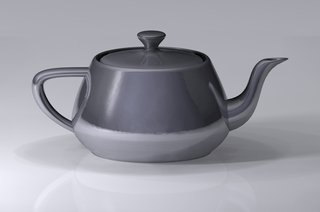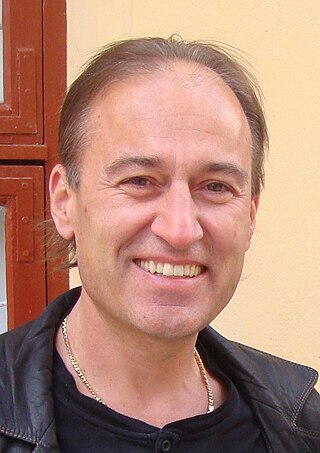
SIGGRAPH is an annual conference centered around computer graphics organized by ACM, starting in 1974 in Boulder, CO. The main conference is usually held in North America though is not limited in location possibilities; SIGGRAPH Asia, a second conference held annually, has been held since 2008 in countries throughout Asia.
ACM SIGGRAPH is the international Association for Computing Machinery's Special Interest Group on Computer Graphics and Interactive Techniques based in New York. It was founded in 1969 by Andy van Dam.
Eurographics is a Europe-wide professional computer graphics association. The association supports its members in advancing the state of the art in computer graphics and related fields such as multimedia, scientific visualization and human–computer interaction.

In statistics and image processing, to smooth a data set is to create an approximating function that attempts to capture important patterns in the data, while leaving out noise or other fine-scale structures/rapid phenomena. In smoothing, the data points of a signal are modified so individual points higher than the adjacent points are reduced, and points that are lower than the adjacent points are increased leading to a smoother signal. Smoothing may be used in two important ways that can aid in data analysis (1) by being able to extract more information from the data as long as the assumption of smoothing is reasonable and (2) by being able to provide analyses that are both flexible and robust. Many different algorithms are used in smoothing.

Noga Alon is an Israeli mathematician and a professor of mathematics at Princeton University noted for his contributions to combinatorics and theoretical computer science, having authored hundreds of papers.
Laplacian smoothing is an algorithm to smooth a polygonal mesh. For each vertex in a mesh, a new position is chosen based on local information and the vertex is moved there. In the case that a mesh is topologically a rectangular grid then this operation produces the Laplacian of the mesh.

Computer graphics is a sub-field of computer science which studies methods for digitally synthesizing and manipulating visual content. Although the term often refers to the study of three-dimensional computer graphics, it also encompasses two-dimensional graphics and image processing.
Emmerich (Emo) Welzl is a computer scientist known for his research in computational geometry. He is a professor in the Institute for Theoretical Computer Science at ETH Zurich in Switzerland.

Tova Milo is a full Professor of Computer Science at Tel Aviv University and the Dean of the Faculty of Exact Sciences. She served as the head of the Computer Science Department from 2011 to 2014. Milo is the head of the data management group in Tel Aviv University, and her research focuses on Web data management. She received her PhD from the Hebrew University in 1992 under the supervision of Catriel Beeri, and was a postdoctoral fellow at the University of Toronto and INRIA, France, prior to joining Tel Aviv University.

Markus Gross is a Professor of Computer science at the Swiss Federal Institute of Technology Zürich (ETH), head of its Computer Graphics Laboratory, and the director of Disney Research, Zurich. His research interests include physically based modeling, computer animation, immersive displays, and video technology. He has published more than 430 scientific papers on algorithms and methods in the field of computer graphics and computer vision, and holds more than 30 patents. He has graduated more than 60 Ph.D. students.
Autodesk Arnold is a computer program for rendering three-dimensional, computer-generated scenes using unbiased, physically-based, Monte Carlo path tracing techniques. Created in Spain by Marcos Fajardo, it was later co-developed by his company Solid Angle SL and Sony Pictures Imageworks.
Holly Rushmeier is an American computer scientist and is the John C. Malone Professor of Computer Science at Yale University. She is known for her contributions to the field of computer graphics.

Hao Li is a computer scientist, innovator, and entrepreneur from Germany, working in the fields of computer graphics and computer vision. He is co-founder and CEO of Pinscreen, Inc, as well as associate professor of computer vision at the Mohamed Bin Zayed University of Artificial Intelligence (MBZUAI). He was previously a Distinguished Fellow at the University of California, Berkeley, an associate professor of computer science at the University of Southern California, and former director of the Vision and Graphics Lab at the USC Institute for Creative Technologies. He was also a visiting professor at Weta Digital and a research lead at Industrial Light & Magic / Lucasfilm.

José Luis Moreira da Encarnação is a Portuguese computer scientist, Professor Emeritus at the Department of Computer Science of the Technische Universität Darmstadt in Germany and a senior technology and innovation advisor to governments, multinational companies, research institutions and organizations, and foundations. He is involved in the development of research agendas and innovation strategies for socio-economic development with a focus on emerging economies. He is also a member of the Topical Network Information and Communication Technology (ICT) and ICT-related activities of the German National Academy of Science and Engineering (acatech) and the German Berlin-Brandenburg Academy of Sciences and Humanities (BBAW). He is an elected member of the ACM SIGGRAPH Academy (USA).
Jessica K. Hodgins is an American roboticist and researcher who is a professor at Carnegie Mellon's Robotics Institute and School of Computer Science. Hodgins is currently also Research Director at the Facebook AI Research lab in Pittsburgh next to Carnegie Mellon. She was elected the president of ACM SIGGRAPH in 2017. Until 2016, she was Vice President of Research at Disney Research and was the Director of the Disney Research labs in Pittsburgh and Los Angeles.
IEEE Transactions on Visualization and Computer Graphics is a peer-reviewed scientific journal published by the IEEE Computer Society. It covers subjects related to computer graphics and visualization techniques, systems, software, hardware, and user interface issues. TVCG has been considered the top journal in the field of visualization.
The Rössler Prize, offered by the ETH Zurich Foundation, is a monetary prize that has been awarded annually since 2009 to a promising young tenured professor of the ETH Zurich in the middle of an accelerating career. The prize of 200,000 Swiss Francs is financed by the returns from an endowment made by Max Rössler, an alumnus of the ETH. The prize money has to be used for the research of the laureate.
Alla Sheffer is a Canadian researcher in computer graphics, geometric modeling, geometry processing, and mesh generation, particularly known for her research on mesh parameterization and angle-based flattening. She is currently a professor of computer science at the University of British Columbia.
Marc Alexa is a professor of computer science at TU Berlin working in the fields of computer graphics, geometric modeling and geometry processing.

Torsten Hoefler is a Professor of Computer Science at ETH Zurich and the Chief Architect for Machine Learning at the Swiss National Supercomputing Centre. Previously, he led the Advanced Application and User Support team at the Blue Waters Directorate of the National Center for Supercomputing Applications, and held an adjunct professor position at the Computer Science Department at the University of Illinois at Urbana Champaign. His expertise lies in large-scale parallel computing and high-performance computing systems. He focuses on applications in large-scale artificial intelligence as well as climate sciences.









